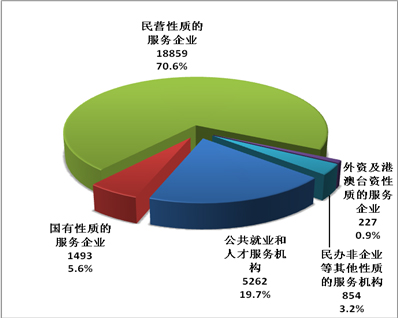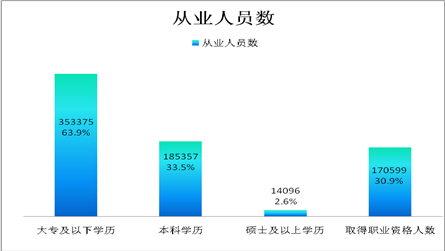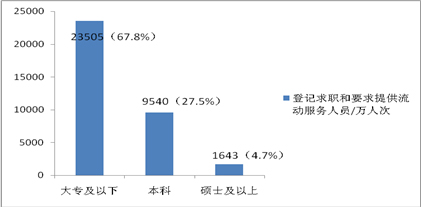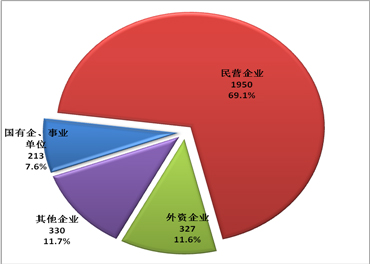2016 Human Resources Market Statistics Report
I. Construction of human resources service institutions
By the end of 2016, there were 26,695 human resources service institutions with 552,828 employees (see Figure 1).
Figure 1 Changes of human resources service institutions and employees

From the category of service institutions, the human resources and social security departments of local governments at or above the county level (including other industry management departments) have set up 5262 public employment and talent service institutions, accounting for 19.7% of the total human resources service institutions; 1493 state-owned human resources service enterprises, accounting for 5.6%; 18,859 private human resources service enterprises, accounting for 70.6%; There are 227 foreign-funded and Hong Kong, Macao and Taiwan-funded service enterprises (including 103 Hong Kong-funded, 2 Australian-funded and 4 Taiwan-funded service enterprises respectively), accounting for 0.9%, and 854 private non-enterprises and other service organizations, accounting for 3.2% (see Figure 2).
Figure 2 Basic information of human resources service institutions in 2016 (unit: home)

According to the classification of the education level of employees, there are 353,375 people with college education or below, accounting for 63.9% of the total number of employees; There are 185,357 undergraduates, accounting for 33.5%; There are 14,096 people with master’s degree or above, accounting for 2.6%; There are 170,599 employees who have obtained qualification certificates, accounting for 30.9% of the total number of employees (see Figure 3).
Figure 3 Education of employees in 2016

By the end of 2016, there were 21,000 fixed recruitment (exchange) places and 11,675 human resources market websites set up by various human resources service institutions across the country. From the perspective of operation and development, the total operating income of the whole industry in 2016 was 1,185 billion yuan (including 879.2 billion yuan for the collection and payment of services such as service outsourcing), a year-on-year increase of 22.4%.
Second, the human resources service business situation
In 2016, all kinds of human resources service institutions nationwide served 694.47 million person-times, a year-on-year increase of 15.4%. There are 346.88 million people registered by various human resources service institutions in China to apply for jobs and ask for mobile services. Classified by academic level, there were 235.05 million people with college education or below, accounting for 67.8% of the total; 95.4 million people with bachelor’s degrees, accounting for 27.5% of the total; There were 16.43 million people with master’s degree or above, accounting for 4.7% of the total (see Figure 4). In 2016, various human resources service agencies nationwide helped 176.74 million people to achieve employment and mobility, up 17.7% year-on-year.
Figure 4 Academic qualifications of registered job seekers and those requesting mobile services (unit: 10,000 person-times)

In 2016, various human resources service institutions nationwide provided human resources services to 28.2 million employers, up 15.9% year-on-year. Among the employers who served, 2.13 million were state-owned enterprises and institutions, accounting for 7.6%; 19.5 million private enterprises, accounting for 69.1%; 3.27 million foreign-funded enterprises, accounting for 11.6%; Other employers made 3.3 million trips, accounting for 11.7% (see Figure 5).
Figure 5 Service Employers (Unit: 10,000 times)

In 2016, all kinds of human resources service institutions in China held 200,000 on-site job fairs (including 65,000 for college graduates and 61,000 for migrant workers). There were 108.7 million job seekers, a year-on-year decrease of 3.66%; The number of participants was 6.88 million, a year-on-year decrease of 2.36%; 100.99 million pieces of job information were provided, a year-on-year decrease of 2.7%. In 2016, all kinds of human resources service institutions nationwide published 285.18 million job recruitment information through the Internet, up 15.7% year-on-year; 592.08 million pieces of job information were released, up 20.9% year-on-year. With the extensive use of new technologies such as the Internet, online recruitment and mobile internet recruitment have flourished. As a result, the number of on-site job fairs, participating units and job seekers have declined to some extent.
In 2016, various human resources service agencies nationwide provided labor dispatch services to 282,000 employers, a year-on-year decrease of 0.6%; 8.76 million people were dispatched, an increase of 0.97% year-on-year; Registration requires 5.52 million personnel to be dispatched, an increase of 0.83% year-on-year. Various human resources service organizations provided human resources outsourcing services to 540,000 employers, with a year-on-year increase of 5.7%.
In 2016, various human resources service institutions nationwide provided human resources management consulting services to 2.29 million employers, a year-on-year increase of 7.7%. Managing 77.16 million floating personnel files, up 5.3% year-on-year; Relying on archives, we provided 44.32 million person-times of services such as salary adjustment, file consulting and issuing relevant certificates, with a year-on-year increase of 3.1%. Held 280,000 training courses, up 9.1% year-on-year; There were 12.08 million trainers, up 8.6% year-on-year. The senior talent search (headhunting) service successfully recommended the hiring of 1.16 million senior talents of various types, with a year-on-year increase of 12.9%.